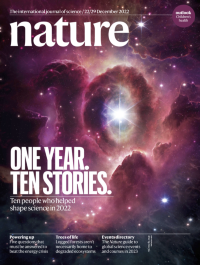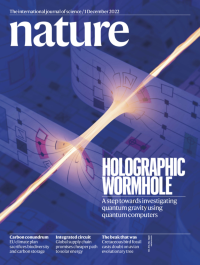Volume 612
-
No. 7941 22 December 2022
One year. Ten stories.As 2022 enters its final weeks, we look back on the past 12 months through the lens of Nature’s 10 — ten people who helped to shape science during the year. The cover takes its inspiration from the stunning images that have so far emerged from the James Webb Space Telescope. Launched on Christmas Day 2021, the telescope sent its first image back to Earth this summer and has since provided astronomers with views of the Universe in unprecedented detail.
Nature Outlook
-
No. 7940 15 December 2022
Ant milkThe cover shows clonal raider ants (Ooceraea biroi) tending to pupae and small larvae. Ants are social insects, and their colonies are complex biological systems with sophisticated communication, behaviour and cooperation. In this week’s issue, Daniel Kronauer and his colleagues reveal previously unnoticed social behaviour involving the immobile pupal stage in the insects’ life cycle. The researchers found that, just before hatching, the pupae secrete a nutrient-rich moulting fluid that is analogous to mammalian milk. This fluid is rapidly consumed by adult ants and young larvae, which the adults place on the pupae. The team notes that larvae unable to access the fluid show stunted growth and have a poor survival rate. Similarly, if the secretions aren’t removed from the pupae, they get fungal infections and die. The researchers also find that the fluid contains hormones and psychoactive substances that might influence the physiology and behaviour of the overall colony.
Nature Index
-
No. 7939 8 December 2022
The lost worldThe cover shows an artist’s impression of the rich ecosystem that existed in parts of northern Greenland some 2 million years ago. The ecosystem is reconstructed from ancient DNA in this week’s issue by Eske Willerslev and colleagues. Working at the Kap København Formation in Peary Land, the researchers gathered sediment samples rich in organic material from 5 different geological sites. By extracting and sequencing DNA from these samples, they were able to piece together a picture of the flora and fauna present around 2 million years ago. The team found evidence of open boreal forest mixed with Arctic species such as cedar, spruce and birch, as well as signs of animals including hares, mastodons, reindeer and geese. The evidence affirms that this part of Greenland, now a polar desert, was 11–17 °C warmer than it is today and suggests it was home to an ecosystem composition that no longer exists anywhere in the world.
Nature Index
-
No. 7938 1 December 2022
Holographic wormholeOne challenge that stems from the fundamental incompatibility between general relativity and quantum mechanics is that there is no consensus on a theory of quantum gravity. A way to potentially overcome this is through the holographic principle, which says that a system involving gravity can be described by a lower-dimensional quantum system. In this week’s issue, Maria Spiropulu and her colleagues replicate the dynamics of a traversable holographic wormhole by experimentally realizing the corresponding quantum dynamics in a quantum computer using 9-qubits. This is an early step towards studying theories of quantum gravity in the laboratory. In the same quantum chip, the researchers created two entangled quantum systems. They inserted a qubit into one of them and observed the information emerging from the other exhibiting the expected gravitational properties of the traversable wormhole.
Focal Point




